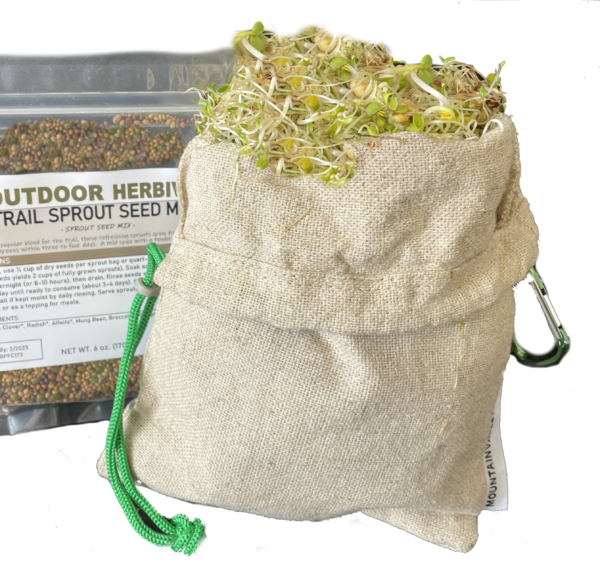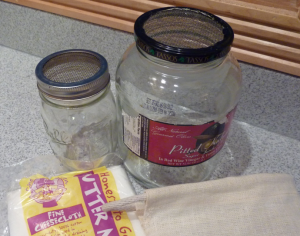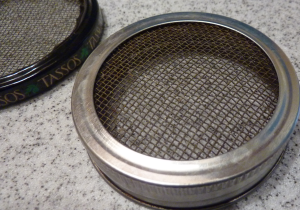Sprouting on the trail is similar to sprouting seeds at home. The process requires soaking, draining, and rinsing seeds regularly until they germinate, which takes about 48 hours. The main difference to sprouting on the trail is that the mechanism you’ll use may be different. A regular mason jar is more convenient at home but heavy and bulky for backpacking. A fabric sack works well for the trail.
The entire process of growing sprouts is easy and is great for long hikes. You can take the sprouts on shorter trips, but we recommend starting the germination process at home. If you are hiking for 2 – 3 days, begin the sprouting process at home (2 days before your hike), then pack them out in a fabric sack. The sprouts will continue to grow for the duration of your hike with the proper care.
Ready to get started?
1. Get a sprouting mechanism
Textile Sack
A fabric bag will offer the lightest weight for the trail and works best since it can hang outside your pack and keep pockets free for essential items. Look for a fabric sack that allows air circulation and light and is woven tightly enough that the seed will not fall through the fabric weave. Hemp fabric works exceptionally well because it is naturally mold resistant and durable. Some people have success with cheesecloth/muslin bags used for making nut milk, as well as hosiery sock liners and aquarium filter media bags.
Plastic or Glass Container
A transparent or opaque plastic Nalgene container works well on the trail or when traveling. A glass quart-sized mason jar works well at home. If using a rigid container, ensure the top has a perforated lid for water drainage and air circulation. The holes should be smaller than the seeds, so they don’t fall through when draining. If using a mason jar, cut out a round section of the window screen and fit it into the metal ring that screws to the top of the jar. Other sources for a ventilated mesh lid include: punching a plastic cover with pinholes, drilling into a metal lid, butter muslin or cheesecloth, pantyhose, and aquarium netting. You can secure the mesh material with a rubber band as the lid.
|
|
2. Obtain Seeds
Purchase organic seeds intended for consumption when sprouting, not garden seed. Sprouting seeds are meant for growing in water and eaten at an early stage of germination. Garden seeds are often chemically treated with fungicides and pesticides to help the seed survive in soil. Garden seeds can be used as long as they have not been treated.
3. Start Sprouting
The process requires soaking, draining, and then rinsing seeds at regular intervals until they germinate, or sprout (about 48 hours). Follow these steps to begin sprouting seed –
a. Measure out the required amount of seed. Sprouts increase in volume 6 – 8 times for greens and 2 – 3 times for beans.
3 – 4 TB of seed is enough for a single batch to grow and fill up an entire quart-sized container or sprout bag.
b. Soak the seeds in fresh water overnight, or about 8 – 10 hours.
If using a sprout bag: you can immerse the bag directly in a bowl of water or soak seeds directly in the container.
c. The next day: Drain off the water, rinse the seeds with fresh water, and drain again.
If using a sprout bag: transfer the seeds to the sprout bag. Shake the bag to remove excess water.
If using a container: turn the jar on its side to allow air to dry any excess water and circulate to the seed.
d. Continue to rinse seeds daily by pouring clean (treated) water over the seeds or immersing the sprout bag in water. Drain the water from the container, or shake the bag to remove excess water.
e. Place the sprouting medium near sunlight. Sprouts do not require light to germinate but should have light once germinated. Indirect or low light will work.
Need additional information? See our detailed instructions for sprouting seed.
4. Eat and Store Sprouts
- You can consume the sprout as soon as the first shoot emerges. Depending on the type of sprout you are growing, the shoot will appear 48 hours after soaking and rinsing the seed. It will have a grainy/chewy texture but is easily digestible.
- Bean sprouts do not become leafy when sprouted; instead, they swell and soften. After about two days, the beans will be soft enough for you to eat.
- Salad-type sprouts, such as alfalfa, broccoli, clover, radish, etc., are usually grown to a more mature leaf stage, which takes about four days.
- Sprouts will stay good on the trail for up to 2 weeks if kept moist by daily rinsing. They are best consumed when fresh within the first week.
- Sprouts grown at home keep best when refrigerated or kept cold. You can store them in the same jar you sprouted from. Ensure the container allows for ventilation because the sprouts will continue growing even in the refrigerator.
This video “How To Make Fresh Sprouts With Sprouting Seed,” presented by mountainroseherbs captures the process well.
Ready to begin sprouting? Outdoor Herbivore offers a trail sprout kit to help you get started. Our starter sprout kit includes 1 hemp sprout bag with an ultralight carabiner, a 6 oz bag of organic sprout seed mix, and instructions. This kit includes everything you need to begin sprouting while on the trail. The hemp sprout bag is designed to hang on your backpack. It can also hang on the rear view mirror when traveling.
See also Outdoor Herbivore’s trail sprouting page.



2 thoughts on “Trail Sprouting”
This is really awesome, thanks for this page! I will thoroughly read it and put your tips into practice when I can get round to it! am going to do a lot of longterm hiking and I think sprouts will be my heath saviour!
This is amazing! We are heading out next week for 5 day’s. I am going to soak my mung beans, or?? and hang off of my pack! Classic Salad!!!